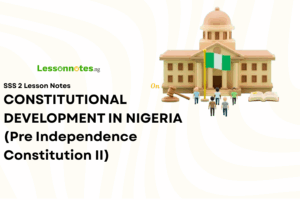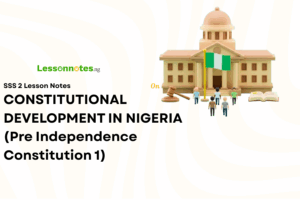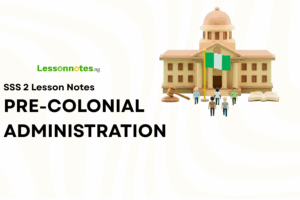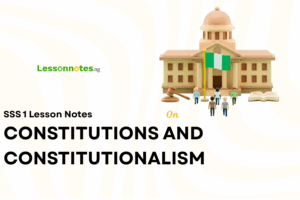Constitutional Development III SS2 Government Lesson Note
Download Lesson NoteTopic: Constitutional Development III
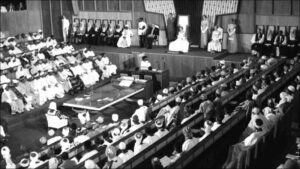
LYTTLETON CONSTITUTION OF 1954
Features Of the Lyttleton Constitution
The resultant defects of MacPherson’s constitution gave rise to two constitutional conferences in 1953 and 1954, the first in London and the other in Lagos. Far-reaching conclusions were agreed on concerning the structuring of Nigeria’s federation, and the status of Lagos as a Natural Federal Unit.
In October 1954 Lyttleton’s Constitution came into effect and the main features and important changes made by it were as follows;
i. It was the first federal constitution adopted by Nigeria.
ii. The lieutenant governors of the various regions became known as Governors.
iii. The governor was known as the Governor-General of the Federation of Nigeria.
iv. Establishment of the office of the speakers and Deputy Speaker of the regional legislatures except for the North.
v. Regionalization of the public service, marketing boards and the judiciary.
vi. Establishment of the office of the regional premier.
vii. Regional legislatures were given law-making powers.
viii. Reduction in numbers of both officials and appointed members in both central and regional legislatures and the executive council.
ix. No provision was made for the office of the prime minister.
x. Division of powers between the central and the regions.
xi. Revision of revenue sharing formula.
xii. Southern Cameroon granted both administrative and legislative provisions.
Important Provisions Of The Lyttleton Constitution
i. Federal House of Representatives: A central legislative body of 184 directly elected based on a single member constituency with the north providing 92, the east and west 42 each. Southern had 6 and Lagos had 2.
ii. Federal Council of Ministers: It was composed of the Governor General, 3 official members, 3 ministers from each region, 1 from Southern Cameroon. The Governor General picked the ministers from the Federal House of iii. Representatives on the advice of the regional executive.
iii. Regional Executive Councils: The Governor appointed the leaders of the party with the majority as the region’s premiers. Regional Governors presided over the regional executive meetings, with ministers appointed on the advice of the premiers.
iv. Regional Legislatures: It retained a bi-cameral feature for the Northern and Western Assemblies and a unicameral legislature for the East.
v. Division of Powers: The constitution divided powers between the central and the regional government of the federation exclusive power list granted the central government control over mining, railways, customs, foreign relations etc. The concurrent list was for the federal and regional governments. The residual list was meant for the regions.
Defects Or Weakness Or Demerits Of Lyttleton’s Constitution
i. It made no provision for the office of the prime minister, still imposing the Governor-General as President of the Council of Ministers.
ii. It did not provide for a second chamber at the Federal Legislative House.
iii. None of the leaders of the major political parties was in the council of ministers, which means those appointed to it would continue to take instruction from the regions. Where their party leaders were stationed.
iv. It did not address the imbalance created by Richard’s Constitution, which made the North twice the size of the whole South. The effect of this structure is still a political problem stalking the country.
v. It did not provide for a uniform electoral system for the country.
vi. The constitution still vested veto power on the Governor General and the regional Governors.
vii. It regionalized the public service thereby making the regions stronger than the central.
Achievements Or Merits Of Lyttleton’s Constitution
i. It introduced a federal structure in Nigeria.
ii. It established the offices of the speaker and deputy speaker.
iii. It introduced direct election into federal and regional legislatures.
iv. Ministers were made heads of departments.
v. It created posts of permanent secretaries and parliamentary secretaries at the federal and regional civil service administration.
vi. It separated Lagos and South Cameroon from the west and east respectively.
vii. It raised the status of Governor to Governor General, and Lieutenant to Governors.
viii. The constitution effectively prepared Nigeria for Independence.
ix. The regional legislatures were granted real law-making [powers. Clear-cut division of powers between central and regional governments.
x. It created dual civil service and judicial administration.
LONDON CONSTITUTIONAL CONFERENCE
This conference was convened to discuss issues surrounding the 1954 Lyttleton constitution. The outcome of the Constitutional Conference of 1957 includes the following;
i. The Eastern and Western regions are to be granted self-government immediately after the conference.
ii. The North would become independent in 1959.
iii. The office of the prime minister of the federation is to be created.
iv. Eastern region to have a house of chief in line with what was obtained in the Northern and Western regions.
v. At the Central Legislature a house of Senate is to be created making it a bicameral legislature.
vi. Southern Cameroon to be made a region with the appointment of a premier.
vii. Membership of the Federal House of Representatives to be enlarged from 184 to 320 at the expiration of its term.
viii. Election into Federal and regional legislatures for the East, West, Lagos and Southern Cameroon should be by universal adult suffrage, but election into the northern legislature to be by adult male suffrage.
ix. Commission of inquiry to be set up to look into the affairs of each region.
x. Governor General to appoint an ad hoc committee to carry out the division of the country into single-member constituencies.
xi. The Government in the region should appoint premiers from the majority representation in regional houses of assemblies.
xii. The Governor-General appoints a prime minister, the person whose party secured a majority in the House of Representatives.
Effects And Implementation Of The Decision Arrived At The Constitutional Conference Of 1957
i. The Eastern and Western regions attained self-government on August 8, 1957.
ii.On September 2, 1957, the Governor-General Sir Abubakar Tafawa Balewa deputy leader of NPC, was appointed as prime minister of the federation.
iii. Southern Cameroon became a separate region with its premier
iv Prime Minister Alhaji Abubakar Tafawa Balewa formed a coalition National government made up of NPC, NCNC, and AG.
v. All ex-officio British officials ceased to be members of the executive council except the governor-general.
vi. The reserved and veto power of the governor-general were withdrawn.
vii. The Willinks Commission was set up to examine fears of the minority groups.








